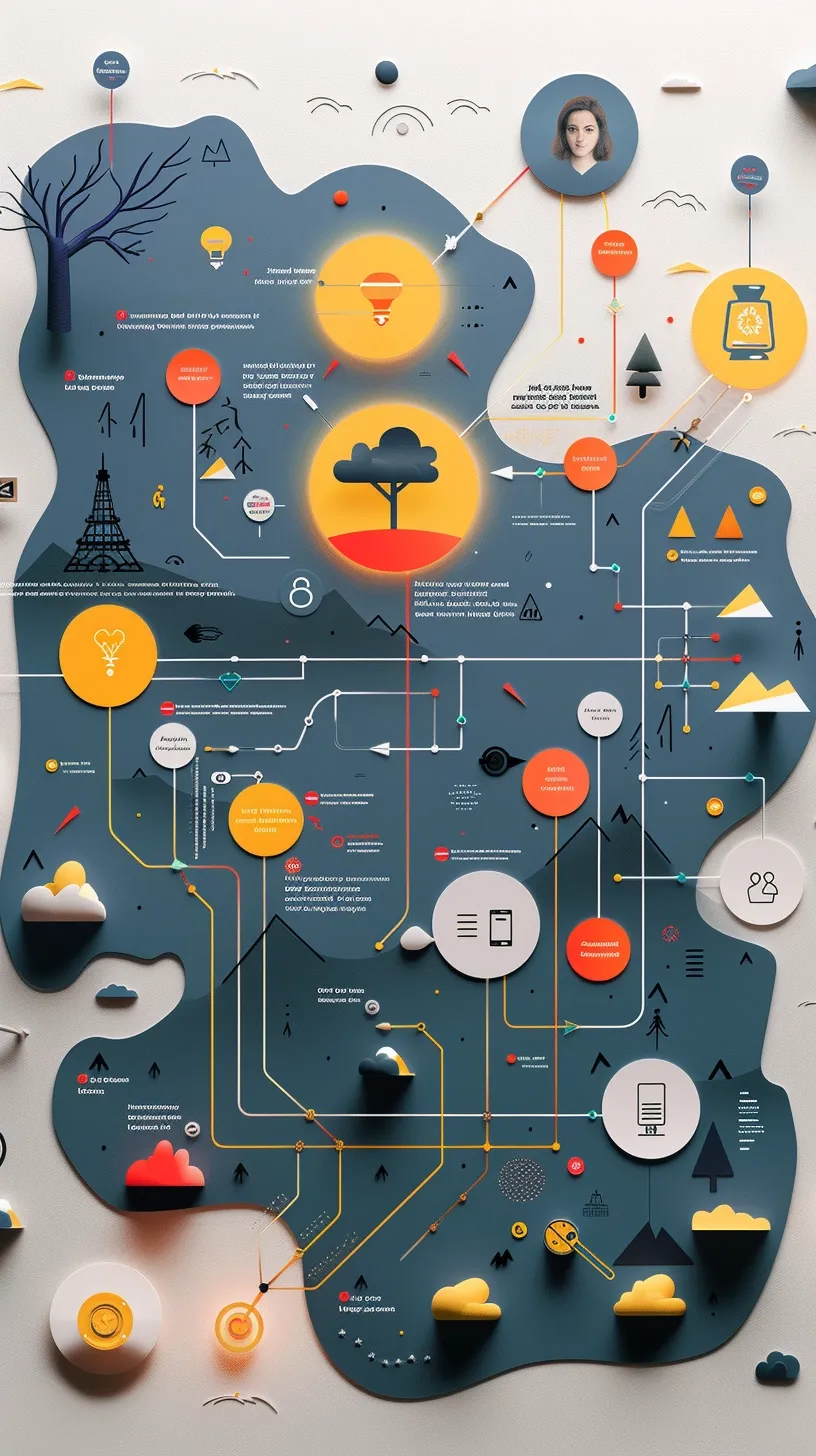Delving into Design for Accessibility
In the swiftly changing digital era, the need to make products, services, and content accessible to everyone, including individuals with disabilities, has transitioned from a desirable feature to an essential requirement. The philosophy behind accessibility in design is to craft experiences that cater to users with diverse abilities. Adopting this inclusive design strategy not only elevates the overall user experience but also underscores the importance of inclusivity—a fundamental principle increasingly demanded by contemporary consumers from the brands they endorse.

Accessibility in design involves ensuring that websites, applications, and digital material are usable by a wide range of individuals, including those with impairments. This includes a variety of problems such as visual, auditory, physical, verbal, cognitive, and neurological difficulties. The objective is to remove obstacles that might hinder engagement with, or entry to, websites and programs, thus guaranteeing that individuals, irrespective of their physical or cognitive capacities, can utilize them.
Ethical and Legal Considerations
Numerous nations have enacted legislation mandating the availability of digital information from a legal standpoint. The European Accessibility Act (EAA) in the European Union and the Americans with Disabilities Act (ADA) in the United States are examples of legislation that businesses must comply with. When considering ethics, designing for accessibility entails ensuring that all individuals have equitable access to services and resources; this aligns with the principles of inclusion and equality.
Effect on brand perception
Accessibility may greatly influence consumers’ perception of your brand. Committing to accessibility shows that a brand loves all consumers and is dedicated to providing a fair user experience. This not only improves the brand’s reputation but also cultivates loyalty among consumers who appreciate inclusion and social responsibility. Accessible design frequently leads to a streamlined, user-friendly interface that is advantageous for all users, not just individuals with impairments.
Explore why certain designs in branding captivate us:

Ignoring accessibility in today’s competitive industry might damage your brand’s reputation. Users may easily share their experiences through social media and online reviews. Criticism about websites or applications that are not available can quickly circulate, thus dissuading potential consumers and harming your brand’s image.
Have a quick read about the role of social media in your branding efforts:
On the other hand, focusing on accessibility may distinguish your company by demonstrating your attention to diversity and supporting a varied consumer base. By doing this, you not only meet legal obligations but also access a broader customer base that may otherwise be left out.

Designing for accessibility is an essential element of contemporary digital strategy. It demonstrates a brand’s dedication to inclusion, improves user experience for all consumers, and upholds ethical and legal responsibilities. Understanding and using accessible design concepts will be crucial for organizations looking to thrive and create a beneficial influence in the digital era.
The Business Case for Accessibility
While designing for accessibility is often viewed through the lens of social responsibility and legal compliance, it also presents a compelling business case. Embracing accessibility can drive market expansion, enhance SEO performance, and ultimately contribute to a brand’s bottom line. Below these benefits will be explored in detail, providing real-world examples of brands that have successfully harnessed the power of accessible design.
Market Expansion
Accessible design opens up your products and services to the estimated 1 billion people worldwide with disabilities. This demographic controls substantial spending power, which often goes untapped by businesses that overlook accessibility. By making your digital presence accessible, you not only reach a wider audience but also demonstrate inclusivity, attracting customers who value equality and diversity.
Learn about brand strategy in the digital era:

Microsoft is a prime example of a brand that has prioritized accessibility, thereby expanding its market reach. The tech giant has incorporated a range of accessibility features into its products, from the Windows operating system to the Office suite, making them more usable for people with disabilities. Features like the Narrator screen reader, Magnifier, and closed captions have made Microsoft’s products more appealing to a broader audience, including individuals with visual, hearing, and cognitive disabilities.
SEO Benefits
Search engines favor websites that are accessible to a wide range of users, including those with disabilities. Implementing accessibility best practices, such as semantic HTML, alt text for images, and easily navigable site structures, can improve your site’s SEO. These elements make your site more understandable to search engine algorithms, which can boost your rankings and visibility.
Spotify provides an outstanding example of how accessibility can enhance SEO. By ensuring its web player is accessible, including providing keyboard navigation and screen reader support, Spotify has improved its service for users with disabilities. These accessibility features also make the site more crawlable by search engines, contributing to higher search rankings and attracting more users to the platform.

Case Studies: Brands Leading with Accessibility
Beyond Microsoft and Spotify, several other brands have made significant strides in accessibility, illustrating the business benefits of this approach.
Adobe: Adobe’s commitment to accessibility is evident in its products and resources designed to help creators produce accessible content. By offering tools and guidelines for creating accessible PDFs and digital experiences, Adobe not only serves a wider range of professionals and consumers but also positions itself as a leader in inclusive software solutions.

Barclays: This global bank has taken significant steps to make its services accessible to everyone, including those with disabilities. Barclays offers a range of accessible banking services, including talking ATMs, high-visibility debit cards, and mobile banking apps designed with accessibility in mind. These initiatives have not only enhanced the customer experience for individuals with disabilities but also strengthened Barclays’ reputation as an inclusive and socially responsible brand.
These examples demonstrate that investing in accessibility is not just about adhering to legal standards or ethical principles—it’s a strategic business decision that can open up new markets, improve your SEO standing, and enhance your brand’s reputation.
Incorporating Accessibility into Your Design Strategy
Integrating accessibility into your design approach is a dynamic process that requires meticulous attention, empathy for various user experiences, and a dedication to ongoing enhancement. We will explore concrete approaches for incorporating accessibility into your design methods, with the backing of examples from businesses that have effectively managed this process.

Optimal Methods for Creating Accessible Design
Success in implementing an effective accessibility plan depends on following recognized best practices and standards, such as the Web Content Accessibility Guidelines (WCAG). The recommendations provide a structure for enhancing web content accessibility for those with impairments. Essential practices consist of:
- Ensuring Textual Alternatives: Ensure accessibility by providing alternative text for photos, video transcripts, and other non-text information to make them accessible to users relying on screen readers.
- Keyboard Navigation: Implement keyboard navigation on your website to allow people to navigate without using a mouse, accommodating those with disabilities.
- Readable and Predictable Content: Use clear language, consistent navigation, and explain complex terms to make content understandable for users with cognitive disabilities.
- Adaptable & Versatile Design: Make sure your website is accessible on various devices such as mobile phones and tablets, catering to people with diverse levels of ability to interact with different displays and interfaces.
Uncover the principles of adapting to new design styles:

Tools and Resources
Various tools and frameworks are available to help assess and enhance the accessibility of your digital assets.
- Accessibility Evaluation Tools: Accessibility evaluation tools such as WAVE, Axe, and Google Lighthouse can assist in detecting accessibility issues on your website.
- Screen Readers: Such as JAWS, NVDA, or VoiceOver can offer valuable insights into the user experience for visually impaired individuals while testing your website.
- Accessibility checklists and guidelines: The WCAG checklist and A11Y Project checklist are detailed resources to help ensure that your website complies with accessibility requirements.
Incorporating Accessibility Feedback
Feedback from actual users with disabilities is invaluable. Implementing mechanisms for collecting and acting on feedback ensures your accessibility efforts are grounded in real-world usage. This can include user testing sessions, feedback forms on your website, and engagement with disability advocacy groups.
Failing to gather feedback is a critical mistake in brand positioning that may lead to losing customers.
Delve deeper into brand positioning mistakes:

Success Stories: Brands Excelling in Accessibility
Multiple businesses showcase the successful incorporation of accessibility into their design strategy, highlighting the potential for beneficial outcomes.
- Bank of America is known for its inclusive banking services, which include talking ATMs, screen reader-friendly online banking, and specialized customer support for clients with disabilities, demonstrating a thorough commitment to accessibility.
- LEGO’s audio and Braille construction instructions are an innovative way to promote inclusion by enabling visually impaired youngsters to interact with LEGO sets on their own, showcasing the brand’s dedication to providing accessible play opportunities.
- Hulu has improved accessibility by providing audio descriptions for the visually impaired and making its platform compatible with screen readers, establishing a benchmark in the entertainment sector.
These businesses demonstrate that including accessibility in your design approach improves the user experience for those with impairments, expands your client base, and boosts brand loyalty.
To implement accessibility effectively, a proactive strategy is necessary, beginning from the early design phase and continuing through development and beyond. By focusing on accessibility, your company can provide more inclusive digital experiences that appeal to a broader audience, showcasing social responsibility and cultivating a favorable brand reputation.

Overcoming Challenges and Looking Ahead
Embarking on the journey to make your digital presence fully accessible is both rewarding and challenging. Despite the clear benefits, businesses often encounter hurdles along the way. Understanding these challenges and how to navigate them is crucial for success. Moreover, staying abreast of future trends in accessibility ensures your brand remains competitive and inclusive.
Common Challenges in Implementing Accessibility
- Resource Allocation: One of the primary obstacles is securing the necessary resources, including time, budget, and expertise. Accessibility can be perceived as a significant investment, especially for small businesses or startups.
- Solution: Start small by prioritizing the most critical accessibility issues that impact a broad user base. Utilize free resources and tools to begin making improvements. Over time, the incremental benefits in terms of wider audience reach and improved user satisfaction will justify the investment.
- Technical Complexity: Accessibility requirements can seem daunting, particularly for older websites or complex applications that were not designed with accessibility in mind.
- Solution: Adopt a phased approach to retrofitting accessibility. Break down the process into manageable tasks, focusing first on high-impact areas. Engage with experts or consult accessibility guidelines to ensure efforts are well-directed.
- Lack of Awareness or Expertise: A common barrier is the lack of understanding about what accessibility entails and how to implement it effectively.
- Solution: Invest in training for your design and development teams. Workshops, webinars, and online courses can enhance their understanding of accessibility standards and best practices.

Future Trends in Accessibility
AI and Automation: Artificial intelligence and automated tools are becoming increasingly sophisticated in identifying and fixing accessibility issues. This trend is expected to continue, making it easier for brands to maintain accessible digital experiences.
Voice Navigation and Control: As voice-activated assistants become more prevalent, designing for voice control and navigation will play a crucial role in accessibility. This approach can significantly benefit users with physical disabilities or those who prefer voice commands.
Inclusive Design as Standard Practice: Accessibility is moving from a niche consideration to a fundamental aspect of design thinking. In the future, designing inclusively will become a standard practice, embedded in the early stages of product development.

Preparing for the Future
To stay ahead, brands should actively monitor advancements in technology and regulations related to accessibility. Engaging with the disability community for feedback and insights is also crucial. This proactive approach ensures that your digital offerings remain accessible to all users, regardless of how technology or user needs evolve.
Designing for accessibility is not just a moral and legal imperative—it’s a strategic advantage that can distinguish your brand in a crowded market. By understanding and overcoming the challenges associated with implementing accessibility, and by keeping an eye on future trends, your brand can build deeper connections with a broader audience, enhance user satisfaction, and foster brand loyalty.
With the progression of society into the future, the importance of accessibility in design is expected to increase. Brands that prioritize accessible design practices now will have an advantage when it comes to navigating the changing requirements of the digital landscape of the future. The opportunity and collective challenge of creating designs that prioritize accessibility extends an invitation to maintain an open, inclusive, and accessible digital environment for all. By adopting this progressive methodology, these brands not only improve the overall user experience but also emphasize their dedication to establishing a digital environment that is more inclusive for forthcoming generations.



